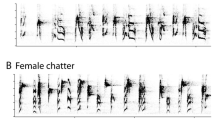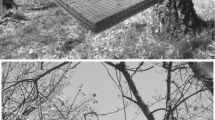Summary
I studied female mate choice in house sparrows Passer domesticus in relation to the size of the black throat patch of males (badge size), which is a signal of dominance status, and to territory quality. Males with large badges obtained a mate earlier in spring than males with small badges. Males which remained unmated during the entire breeding season had smaller badges than mated males, even when controlling for the effect of other morphological traits and age. Largebadged males had territories with more breeding sites than small-badged males. Territories defended by males with large badges primarily had hole nest sites, which were safe from predators, and nestlings rarely fell from hole nests. Females were implanted with estradiol to induce copulation solicitation displays. Females responded more strongly to a male taxidermic mount and song than to song alone, and they responded more strongly and frequently to male mounts with large badges. Female house sparrows chose mates on the basis of male badges and perhaps on the basis of the quality of the nesting territories offered.
Similar content being viewed by others
References
Alatalo RV, Lundberg A, Glynn C (1986) Female pied flycatchers choose territory quality and not male characteristics. Nature 323:152–153
Arnold SJ, Wade MJ (1984) On the measurement of natural and sexual selection. Evolution 38:709–734
Baker MC, Spitler-Nabors KJ, Bradley DC (1981) Early experience determines song dialect repponsiveness of female sparrows. Science 214:819–821
Baker MC, Bjerke TK, Lampe H, Espmark Y (1986) Sexual response of female great tits to variation in size of males' song repertoires. Am Nat 128:491–498
Baker MC, Bjerke TK, Lampe HU, Espmark YO (1987) Sexual response of female yellowhammers to differences in regional song dialects and repertoires. Anim Behav 35:395–401
Burrows WH, Titus HW (1939) Some observations on the semen production of the male fowl. Poultry Sci 18:8–10
Catchpole CK, Dittami J. Leisler B (1984) Differential responses to male song repertoires in female songbirds implanted with oestradiol. Nature 312:563–564
Cink C (1977) Winter behavior of the house sparrow. PhD thesis, University of Kansas, Lawrence
Flood NJ (1984) Adaptive significance of delayed plumage maturation in male northern oriole. Evolution 38:267–279
Fugle GN, Rothstein SI, Osenberg CW, McGinley MA (1984) Signals of status in wintering white-crowned sparrows (Zonotrichia leucophrys gambelii). Anim Behav 32:86–93
Hansen AJ, Rohwer S (1986) Coverable badges and resource defence in birds. Anim Behav 34:69–76
Hansen P (1974) A comparative study of vocal behaviour of house sparrow Passer domesticus and tree sparrow Passer montanus. MSc thesis, University of Aarhus, Aarhus [Danish, English summary]
Innis GS, Balph MH, Balph DF (1985) On spatial requirements of captive social animals. Anim Behav 33:680–682
Järvi T, Bakken M (1984) The function of the variation in the breast stripe of the great tit (Parus major). Anim Behav 32:590–596
Kroodsma DE (1977) Correlates of song organization among North American wrens. Am Nat 111:995–1008
Lack D (1954) The natural regulation of animal numbers. Clarendon Press, Oxford
Lyon DE, Montgomerie RD (1986) Delayed plumage maturation in passerine birds: reliable signaling by subordinate birds. Evolution 40:605–615
Martin PA, Dzuik PJ (1977) Assessment of relative fertility of males (cockerels and boars) by competitive mating. J Reprod Fert 49:323–329
Martin PA, Reimers TJ, Lodge JR, Dzuik PJ (1974) The effect of ratios and numbers of spermatozoa mixed from two males on the proportion of offspring. J Reprod Fert 39:251–258
Møller AP (1987a) Variation in badge size in male house sparrows Passer domesticus: evidence for status signalling. Anim Bchav 35:1637–1644
Møller AP (1987b) Social control of deception among status signalling house sparrows Passer domesticus. Behav Ecol Sociobiol 20:307–311
Møller AP (1987c) House sparrow, Passer domesticus, communal displays. Anim Behav 35:203–210
Møller AP (1988) Badge, body and testes size in House Sparrows Passer domesticus. Ornis Scand (in press)
Parker JF, McKenzie FF, Kempster HL (1940) Observations on the sexual behavior of New Hempshire males. Poultry Sci 19:191–197
Procter-Gray E, Holmes RT (1981) Adaptive significance of delayed attainment of plumage in male American redstarts: tests of two hypotheses. Evolution 35:742–751
Rohwer S (1975) The social significance of avian winter plumage variability. Evolution 29:593–610
Rohwer S, Fretwell SD, Niles DM (1980) Delayed maturation in passerine plumages and the deceptive acquisition of resources. Am Nat 115:400–437
Searcy WA (1982) The evolutionary effects of mate choice. Ann Rev Ecol Syst 13:57–85
Searcy WA (1984) Song repertoire size and female preferences in song sparrows. Behav. Ecol Sociobiol 14:281–286
Searcy WA, Marler P (1981) A test for responsiveness to song structure and programming in female sparrows. Science 213:926–928
Selander RK (1965) On mating systems and sexual selection. Am Nat 99:129–141
Shields WM (1977) The social significance of avian winter plumage variability: a comment. Evolution 31:905–907
Siegel S (1956) Nonparametric statistics for the behavioral sciences. McGraw-Hill Kogakusha, Tokyo
Sokal RR, Rohlf FJ (1981) Biometry, 2nd edn. Freeman, San Francisco
Studd MV, Robertson RJ (1985) Life span, competition and delayed plumage maturation in male passerines: the breeding threshold hypothesis. Am Nat 126:101–115
Summers-Smith D (1963) The house sparrows. Collins, London
Svensson L (1984) Identification guide to European passerines, 3rd edn. Privately published, Stockholm
Watt DJ (1985) A comparative study of status signalling in sparrows (genus Zonotrichia). Anim Behav 29:593–610
Author information
Authors and Affiliations
Rights and permissions
About this article
Cite this article
M//oller, A.P. Badge size in the house sparrow Passer domesticus . Behav Ecol Sociobiol 22, 373–378 (1988). https://doi.org/10.1007/BF00295107
Received:
Accepted:
Issue Date:
DOI: https://doi.org/10.1007/BF00295107




